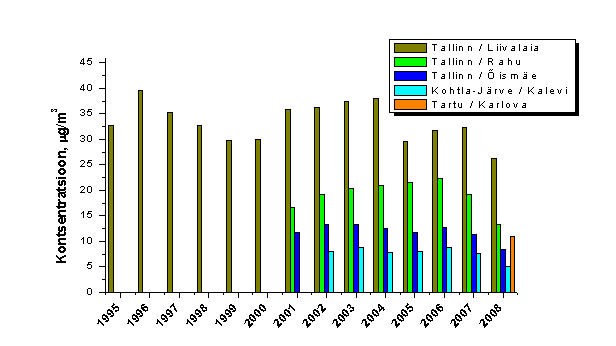Published: 26 Nov 2010
Modified: 17 Feb 2025
Link to Environmental Indicators: http://www.keskkonnainfo.ee/index.php?lan=EN&sid=766&tid=693&l1=2
Link to Air Quality Management System (in Estonian): http://mail.klab.ee/seire/airviro/
· Nitrogen dioxide (NO2)
The level of ambient air pollution by nitrogen dioxide (NO2), measured at urban monitoring stations, shows a decreasing trend during recent years (Figure 1) and is below the EU’s annual limit value. The main reason is the introduction of catalytic converters in passenger cars.
Pollution levels at background stations have hardly varied in recent years (Figure 2) and are also below the annual limit value.

Figure 1. NO2 annual mean concentrations, urban stations

Figure 2. NO2 annual mean concentrations, background stations
· Ozone (O3)
Ground-level ozone (O3) concentrations at background stations are higher than at urban stations. Concentrations at background stations have decreased slightly in recent years (Figure 3). The number of exceedances of the EU’s 8-hour target value for the protection of human health (120 µg/m3) also has decreased considerably in recent years. The largest number of exceedances, 11, in 2008 was at the Lahemaa background monitoring station (Figure 4).


Figure 3. O3 annual mean concentrations, Figure 4. Number of exceedance of 8h target
background stations value O3 limit value, background stations
· Particulate Matter (PM10)
Air can be contaminated by a range of different particles such as dust, pollen, soot, smoke, and liquid droplets. Many of these can harm our health, especially very small particles that can enter deep into the lungs.
Air pollution by particles is the main problem in Tallinn, especially in the centre, where there has been considerable growth in annual mean concentrations of PM10 and in the number of exceedances of the limit value set for the protection of human health, 50 µg/m3 daily mean, (Figure 5). There were 63 exceedances at the Liivalaia monitoring station in 2008 (Figure 6). The main sources of the PM10 emissions in the centre of Tallinn are fuel burning in vehicle engines, especially diesel; road abrasion; automobile tyre and brake wear and also some construction works.
The analysis in Health impact assessment of particulate pollution in Tallinn using fine spatial resolution and modelling techniques (Orru et al., 2009; http://www.ehjournal.net/ content/8/1/7) has shown that all the citizens of Tallinn are affected by poor air quality. Even though the levels of particulates are not high, negative health effects still occur. The analysis suggests that locally-emitted air pollution in the city could be resulting, each year, in 296 premature deaths, corresponding to 3 859 years of life lost (YLL), and 275 short-term hospital admissions. Air pollution is estimated to reduce the life expectancy of Tallinn residents by an average of 7.7 months – the corresponding figure for all EU citizens is 8.6 months. This makes particle pollution a significant environmental health issue in Tallinn.
Similar research has been done for four other cities of Estonia: Tartu, Kohtla-Järve, Narva and Pärnu. On average the results suggest 166 premature deaths each year, corresponding to 2 200 YLL and an average loss of about 8 months of life expectancy. http://www.envir.ee/orb.aw/class=file/action=preview/id=1096278/++++%D5husaaste_tervisem%F5ju_hinnang_TKJNP.pdf (in Estonian only)

Figure 5. PM10 annual mean concentration, urban stations

Figure 6. Number of exceedance of PM10 limit value, urban stations
· Precipitation chemistry
The mean annual concentrations and depositions of sulphate and nitrate decreased significantly between 1995 and 1996 due to reductions of acidifying pollutants.
Recent results of measurements of the mean annual concentrations and depositions of sulphate (Figure 6) and nitrate (Figure 7) in precipitation at the Vilsandi background monitoring station show some decreases or stable levels.

Figure 7. S concentration (mgS/l), deposition (mg/m2) and precipitation (mm), Vilsandi background station

Figure 8. NO3/N concentration (mgS/l), deposition (mg/m2) and precipitation (mm), Vilsandi background station








Document Actions
Share with others